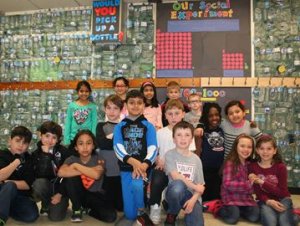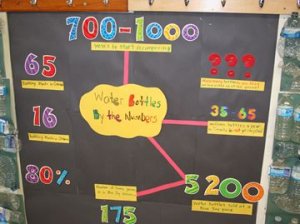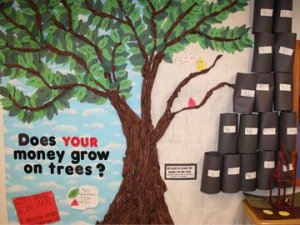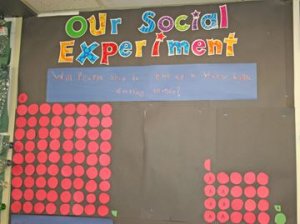
Ancaster Meadow students naïve on water no more
Richard Leitner
Ancaster News

Students in Rhonda Urfey’s Grade 3 class have incorporated the hundreds of discarded water bottles they’ve collected since October into an exhibit offering a closer look at their environmental impacts. Photo by Richard Leitner
The project began small — prompted by questions Grade 3 students had after their teacher, Rhonda Urfey, collected more than 40 empty water bottles littering Ancaster Meadow Elementary School’s grounds one day back in October.
But it quickly blossomed into much more, including a videotaped rant that earned a thumbs-up from comedian Rick Mercer, a study on how many people ignore litter and an exhibit on the impact of water bottles that’s taken over a neighbouring portable classroom.
“At first it was more of a math investigation because we were asking questions like, how many bottles every day were being left (on the playground),” Urfey says.
“Then they started wondering how much ground it would cover, and then we started learning how much oil it would take to make the water bottles,” she says. “It started getting bigger and bigger.”
Students drew inspiration from reading the book Ordinary Mary’s Extraordinary Deed, the story of how one girl’s anonymous act of kindness to a neighbour sparked a chain reaction of similar deeds.
They also watched an exposé on CTV’s W5 program highlighting the $3.71 Swiss company Nestlé paid Ontario for every million litres of groundwater it uses, as well as a rant on the CBC’s Mercer Report that gave them the idea to do one of their own.

Students researched a variety of interesting facts, including how many bottles of water are sold at the average Blue Jays game (5,200).
Their five-minute segment features a succession of students entering and leaving the camera’s view via school doors as they offer rapid-fire statistics and arguments poking holes in the bottled water industry’s claims.
Students tell viewers they don’t really know what they’re drinking when they buy bottled water, unlike with city tap water, which is constantly monitored, and take aim at producers’ statements that bottled water is good for the environment.
They note that 35 million water bottles aren’t recycled each year in Toronto alone and say Fiji Water’s promise to help rainforests fails to account for the oil drilling, petrochemical factories, carbon emissions and transportation its product requires.
“Here’s an idea for being eco-friendly,” two students declare, poking fun at Fiji Water’s commitment to help protect rainforests. “Stop making all those bottles.”
Nestlé and Evian also come under fire, the latter criticized for insulting people with an ad campaign advising, “Don’t be naïve, drink bottled water,” when the French company’s name spelled backwards is Naïve.

Students created a money tree measuring how much Nestlé makes (green leaves) compared to what it pays (red leaf) for using Ontario groundwater.
“Please, rethink your drinks!” they shout at the end.
The video rant was sent to Mercer and he responded with a 16-second clip filmed on the set of the Mercer Report.
“I think it’s great that you’re learning to find your own voices and I admire your enthusiasm,” he tells the class. “Good job, keep up the great work.”
Students also wrote a letter to the Ancaster News in response to a letter against fluoride in tap water, noting one bottled-water label they read listed fluoride as an ingredient and arguing the cavity-fighting mineral isn’t harmful in the tiny levels in tap water.
By that time, they’d collected hundreds of water bottles from their school property, now incorporated in the exhibit in the portable next door.
The bottles cover most of one wall, complemented by a display on a social experiment that had them observe how many students and adults picked up bottles littering school area.
The results weren’t encouraging: only one of 293 people picked up bottles on the playground — and even then, put it in the garbage — while five of 82 did so for bottles by the front foyer.
The exhibit also features models, artwork and other visual representations of bottled water’s environmental impacts.

Students counted the number of people who picked up discarded water bottles on the school grounds. Each circle represents four people, with red for those who ignored the bottles and green for those who picked them up.
Urfey says the class plans to invite school board and city officials to view the exhibit, and hopes to open it up for public viewing, either in person or possibly through a virtual tour.
The class will also be showcasing its work at the Ancaster Fairgrounds on May 3 as part of a city-board Chase the Future initiative.
“Our job is to spread the news and hope people get on board with us,” she says.
Richard Leitner is a Regional Reporter for Hamilton Community News (Ancaster News, Dundas Star News, Mountain News and Stoney Creek News). He can be reached at [email protected]
Updated on Thursday, April 13, 2017.